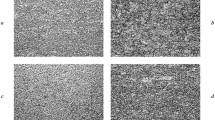Conclusions
-
1.
By means of mathematically planned experiments it was found that the isoforming temperature has the largest effect on the mechanical properties of steels in comparison with other isoforming parameters.
-
2.
The optimal combination of mechanical properties of steels of the 10GN, 09G2, and 15G types is obtained after isoforming at 650–680°C (total reduction 50%, holding time ∼12 min); for steels with vanadium and niobium the isoforming temperature is ∼700°C (total reduction 50%, holding time 10–12 min). Use of combined hardening (isoforming and microalloying) increases the strength (σ0.2 by 45–50%, σb by 25%) in comparison with that obtained after normalization witha n=7.0 kgf-m/cm2 and TX=−60 to −80°C.
-
3.
The optimal combination of mechanical properties of low-alloy structural steels after isoforming is due to the formation of a perfect subgranular structure in excess ferrite and pearlite with fragmented and clustered particles of cementite. In steels with vanadium and niobium the carbides are precipitated in the boundaries and within subgrains, which leads to additional hardening.
-
4.
Warm rolling and isoforming under similar conditions produce similar mechanical properties and identical structures in low-alloy structural steels.
Similar content being viewed by others
Literature cited
I. N. Golkov, M. I. Gol'dshtein, and I. I. Murzin, Vanadium in Steel [in Russian], Metallurgiya, Moscow (1968).
A. P. Gulyaev, O. N. Meshcherinova, and V. N. Zikeev, "Effect of vanadium on the heat resistance of structural steels", in: Transactions of the Central Scientific-Research Institute of Ferrous Metallurgy [in Russian], No. 65 (1968), p. 63.
J. Irani, JISI,206, No. 4, 363 (1968).
Yu. G. Virakhovskii, Ya. B. Gurevich, and A. V. Krupin, "TMT of steel in the process of the austenitic-pearlitic transformation", Stal', No. 8, 752 (1971).
R. Craik, M. May, and D. Latham, Met. Eng. Q.,9, No. 3, 12 (1969).
H. Pagueton, These Doct. Ing. Fac. Sci. Univ. Nancy (1970).
B. Z. Belen'kii, V. M. Farber, and M. I. Gol'dshtein, "Fine structure of steel after deformation in the course of the pearlitic transformation", Izv. Vyssh. Uchebn. Chern. Metall., No. 10, 109 (1973).
V. M. Farber, B. Z. Belen'kii, and Yu. E. Freidenzon, "Isoforming of low-carbon steel alloyed with vanadium", in: Heat Treatment and Physics of Metals [in Russian], Tr. Vuzov Rossiiskoi Federatsii, No. 1, UPI, Sverdlovsk (1973), p. 8.
V. V. Nalimov and N. A. Chernova, Statistical Methods of Planning Extremal Experiments [in Russian], Nauka, Moscow (1965).
M. L. Bernshtein et al., "Effect of deformation of supercooled austenite on the pearlitic transformation", Izv. Vyssh. Uchebn. Zaved., Chern. Metall., No. 3, 127 (1974).
V. M. Farber, B. Z. Belen'skii, and M. I. Gol'dshtein, "Determining the strength of low-carbon low-alloy steels from structural data", Fiz. Met. Metalloved.,39, No. 2, 403 (1975).
Additional information
S. M. Kirov Ural Polytechnical Institute. Ural Scientific-Research Institute of Ferrous Metals. Translated from Metallovedenie i Termicheskaya Obrabotka Metallov, No. 10, pp. 13–19, October, 1978.
Rights and permissions
About this article
Cite this article
Gol'dshtein, M.I., Farber, V.M. & Belen'kii, B.Z. Isoforming and wárm rolling of low-carbon structural steels. Met Sci Heat Treat 20, 799–805 (1978). https://doi.org/10.1007/BF00703774
Issue Date:
DOI: https://doi.org/10.1007/BF00703774



